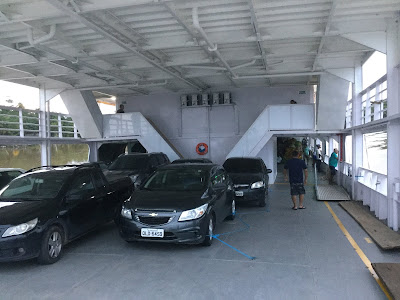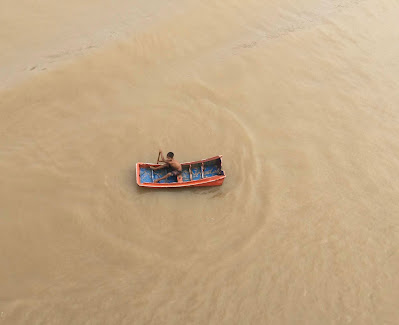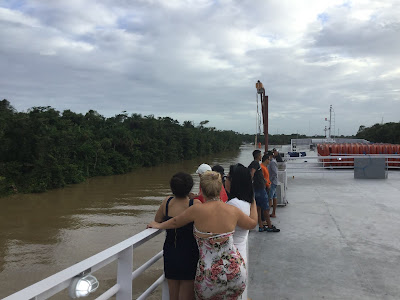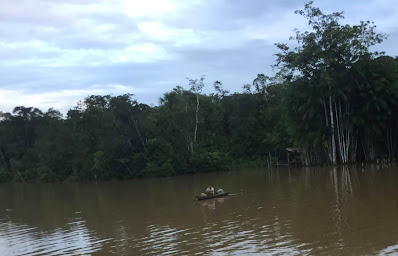It would have been a novel experience to be among them, but I felt obligated to guard my bike, or at least all the gear on it. Lonely Planet warned that thieves were known to grab packs and toss them overboard to accomplices in boats and then dive into the water. One had to be more wary of that on the popular week-long trips to Manaus that all the backpackers and tourists are drawn to than the ferry to Macapa.
So few travelers venture to Macapa that the 700-page Lonely Planet guide to Brasil didn’t mention it, even though it’s a city of half a million people. Nor did Lonely Planet have anything to say about the sector I was venturing into to the Guianas. Looking around at my fellow passengers, none seemed the seedy, thieving type, but I still felt inclined to keep an eye on my gear even after I learned a crew member was somewhat on guard duty.
It was just big enough for fourteen compact cars, seven in the front part of the ferry and seven in the rear where my bike resided.
It had no seating area other than a small cafe of ten tables at the back of the car deck and a two-tabled cafe at the rear of the upper hammock deck. The top deck had a long bench at its rear, but was otherwise uncovered open space.
I quickly drifted off to sleep, even though it wasn’t even seven p.m. My body had been in recuperation-mode all day, having spent it sitting in the air-conditioned ferry terminal as it drizzled outside, as I awaited the three p.m. departure. With my body in shut-down I felt drowsy and capable of taking a nap at any time, so was happy to be forced to somewhat prematurely begin my night’s sleep. The rocking seemed to dissipate during the night.
When daylight began streaming in I was quite taken aback to notice thick jungle not fifty feet from the boat as I looked towards what I thought was the east and wide open water.
My first thought was I had gotten on the wrong boat and was headed upriver to Manaus, but I knew that couldn’t be the case as my ticket had been checked twice before I boarded and I’d even confirmed I was in the correct line. I was equally surprised when looking to the other side that jungle was equally close, as if we were passing through a channel. I quickly turned to my iPad and checked the GPS. I discovered that we hadn’t headed out to the Atlantic, but were following an intricate network of rivers to the west of the huge island of Marajo, as big as Switzerland, in the mouth of the Amazon.
We remained on narrow waterways much of the way, though crossed main arteries of the Amazon from time to time. It was immense. One nearly needed binoculars to see across it. The Mississippi was a mere trickle in comparison.
We could see the smiles on people’s faces and the patterns on their clothes hanging to dry.
I retreated to the upper hammock deck and sat on my ensolite pad with there being no chairs. I had been expecting to do a fair amount of reading, but the scenery was too mesmerizing to read much, though I was able to finish Sara Philippe’s Wesleyan thesis “Everything Has Become Southern: The Confederado Colony in Santarém, Brasil.”
Santarém was several hundred miles up river from where I was about halfway to Manaus, so I could relate to their experience. The couple hundred southerners who ventured to Santarém after the Civil War did not have an easy time of it. Within ten years most had returned to the US, many transported back by US ships sent to Belém to rescue them. Unless they were willing to work very hard themselves, they weren’t likely to succeed, as it was difficult to find locals, especially among the Indigenous people, who were prepared to work more than sporadically.
Few of the Southerners had the funds for slaves or the necessities requisite for success having lost most of their resources during the Civil War. And the Brasilian government didn’t hold true to promises it had made them to wave import taxes on essential equipment, one of the reasons the US government felt justified to rescue them.
Though Philippe doesn’t examine other groups of Southerners that ventured to Brasil, those that went where the weather wasn’t so hot had greater success. The Amazon was simply too steamy and demanding, thwarting them just as it did Henry Ford sixty years later not too far from Santarém where he attempted to set up a rubber manufacturing operation.
Fortunately there was no WiFi on the boat to distract me, but it did have ample electrical outlets for charging and that Brasilian essential, ice water dispensers, on three of the decks. I appeared to be the only non-Portuguese speaker and the only English speaker. Not a soul attempted to speak to me. One of the 14 cars though had a bike mounted on its back. Just about everyone was in shorts and flip-flops. A few wore soccer jerseys, though no one had a ball to kick around.




















3 comments:
Amazing
AMERICAN FACTORY LES MISERABLES,HONEYLAND,PAIN And GLORY all received Oscar nominations
One of your best posts ever. And that is saying a lot! Rick
Post a Comment